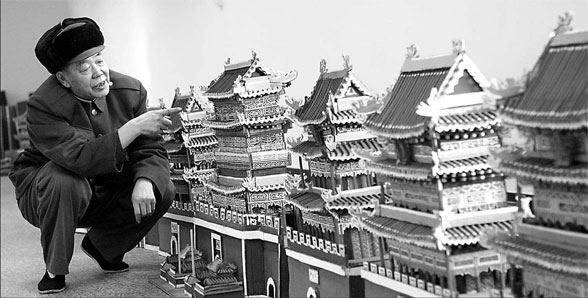The big picture, in minature
|
Ma Yuquan introduces the cardboard replicas of Beijing's nine ancient gates that he created. |
It was a freezing winter's day in Beijing. In an almost-empty unheated storage space in the Fengtai District, Ma Yuquan busied himself with piles of cardboard that lay against the wall.
His face streaming with sweat, the 65-year-old military veteran tried to categorize the colorful cardboard molds, which looked like a miniature segments of the Great Wall. Once in a while, he murmured with anger, "How can they treat these things like that! It is all messed-up."
He selected four ancient Chinese towers and several gates and walls, which were less than 80 cm tall and marked "de sheng men". He joined them together to form a small, enclosed square.
His daughter, Ma Zhao, a fine arts undergraduate, offered to help but the father replied: "I can manage it myself. You don't know how to arrange them in the right order."
Feeling exhausted, he sat on an upside-down bucket, and lit a cigarette.
"These are what the Xizhimen, Deshengmen and Andingmen gates, from west to east, used to look like. The square I sit in is Deshengmen, where I was born and grew up," he says.
"The room is still far too small to hold all the nine cardboard miniatures of Beijing's ancient gates. The whole set covers an area of around 150 sqm," he says.
Ma's family opened a gallery in Xicheng District last December for his cardboard miniature replicas. His large model of Beijing's nine ancient gates has become the main attraction.
The space where Ma is temporarily storing his art belongs to his brother-in-law's company. Some of the units have broken because they are frequently moved. "I need time to repair it and repaint. I told the removal company to be careful. They didn't take me seriously," he says.
"For people of my generation, who have seen the models, they renew our cherished memories of old Beijing life," he says.
It is said that if you want to know more about Beijing, you should study its nine inner gates. In fact, the capital is also referred to as "Nine Gates" (jiu men). Most of them are names of subway stations along the Second Ring Road. Deshengmen is one of the few gates that are still preserved, besides Zhengyangmen.
Born in 1943, Ma spent his childhood in a destitute neighborhood, north of Deshengmen. He recalls that each gate consisted of four parts, including the watchtower (jian lou), two water gates (zha lou) and the gate tower (cheng lou), which formed an enclosure (weng cheng).
Ma says that he used to climb onto the disused gates.
"The Deshengmen Gate we see today is actually the embrasured watchtower," he says.
"The platform of the watchtower was about 18-m wide. There was nothing inside the towers. Both the watchtower and gate tower had two pathways, the former of which, I think, were for armies and the latter for horses," he recalls.
The features that he liked best were a couple of wooden dragon heads on both ends of the watchtower's eaves, one of which was broken by lightning on a stormy night.
He also remembers a mysterious old maid who lived in a small temple at the foot of Deshengmen.
"The poor people in my neighborhood couldn't afford to see a doctor. They all asked for the granny's help when they were sick. I felt uncomfortable one day.
"She poured some ashes from incense sticks into a bowl of water and fed it to me. A few minutes later, my belly didn't hurt any more. It is unbelievable."
When the river in front of Deshengmen froze in winter time, young Ma would chisel the ice and sell the blocks to the nearby icehouse.
Ma's ambitious project to recreate the glory of the nine gates started in 2005.
"I saw a lot of TV programs and exhibitions about Beijing's gates, merely displayed as black-and-white photos. There was no model to help people visualize the past magnificence of those gates," he says.
He believes he has found a way to showcase not only the city's well-designed layout but also its rich life to visitors, particularly those coming for the Olympic Games. "There is a treasure trove of anecdotes behind every gate," he says.
However, the idea first came to him 40 years ago when he was working on a construction site, after retiring from military. Gradually, he fell in love with painting and ancient Chinese architecture.
Ma constructs images in his mind, mainly based on his childhood memories and vintage photos. He outlines different parts of the gates and cuts them out of cardboards, which he gets from others and scrap collectors.
"I tried several kinds of cardboard but only the cardboard from refrigerator boxes is thick enough," he says.
When he assembles the units, he uses segments from chopstick as small roof tiles and sorghum stems as poles. He paints the wall in gray and the tiles in green and black.
"The city gates should look simple and venerable and have cold colors that were believed to prevent fires," he explains.
"The drawings and patterns on other parts are not only decorative but also protect wood from worms and sudden changes in climate."
It took Ma two years and two months to finish the cardboard model of the nine gates, which is comprised of 36 towers and 48 walls. To complete the project he used 1,500 pieces of cardboard and 200 bottles of glue.
He is now working on a cardboard miniature of Wofo Temple, and has already finished the lobby. He also plans to add a railway and trains that circle the nine-gate miniatures.
"I hope that there will be a permanent exhibition in a hall big enough to exhibit the model, so that people can appreciate the intelligence of the old architects of Beijing," he says.
(China Daily 01/08/2008 page20)















